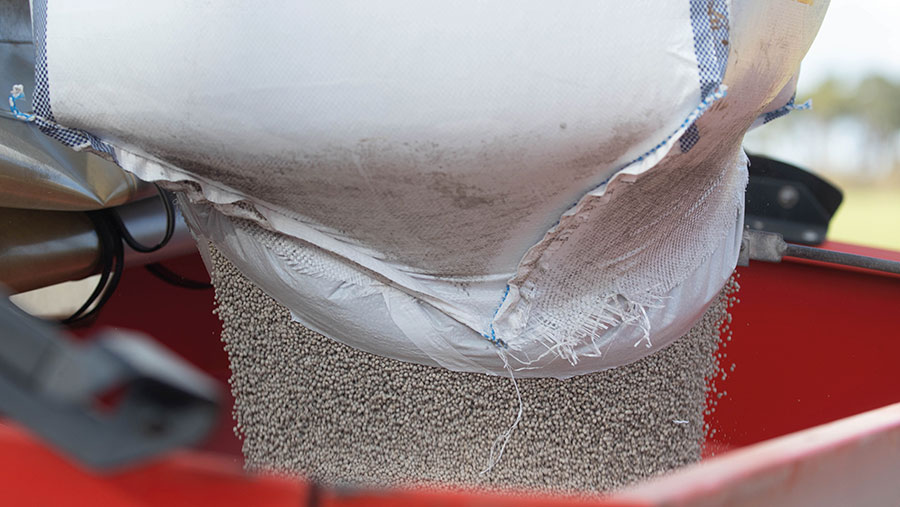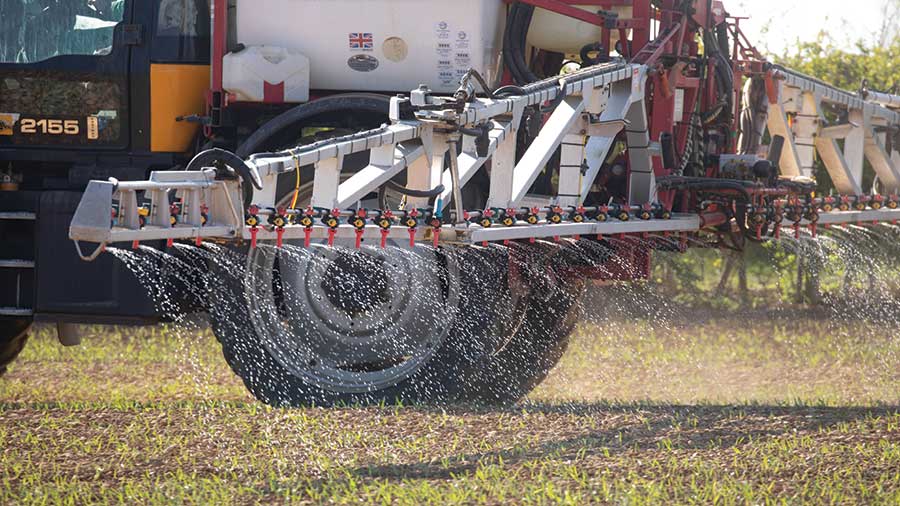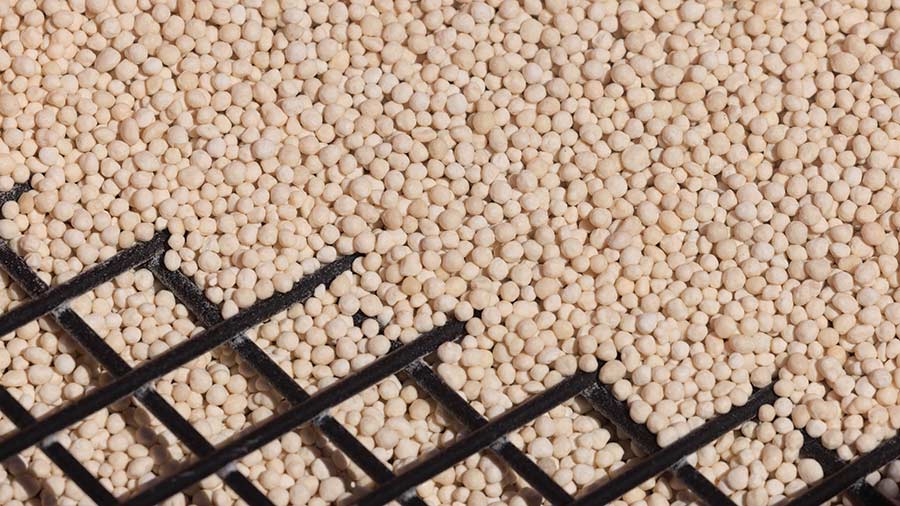Arable Insights farmers share spring nitrogen plans
 © Tim Scrivener
© Tim Scrivener Eight new Arable Insights farmers provide a barometer on fertiliser strategy for the coming season.
We hear from each of the farmers on the current state of their cropping plans.
See also: Video: Lincs wheat grower claims top prize in 2023 YEN Awards
Who are the eight Arable Insights farmers for 2024? |
|||
|
Region |
Name |
Address |
Farm size |
|
North |
Tamara Hall |
Beverley, Yorkshire |
680ha |
|
Northern Ireland |
Neill Patterson |
Downpatrick, County Down |
260ha |
|
West Midlands |
Rob Atkin |
Uttoxeter, Staffordshire |
440ha |
|
South |
Tom Carr |
Fareham, Hampshire |
1,296ha |
|
East Midlands |
Heather Oldfield |
Kirton Drove, Lincolnshire |
200ha |
|
Scotland |
David Fuller-Shapcott |
Kelso, Borders |
369ha |
|
South West |
Dougal Hosford |
Blandford, Dorset |
800ha |
|
East Anglia |
Jack Smith |
Haddenham, Cambridgeshire |
1,830ha |
Scotland: David Fuller-Shapcott, Sweethope Farm
A combination of slugs and prolonged anaerobic conditions following heavy rain has led David Fuller-Shapcott to write off 50% of the 67ha of winter wheat he managed to drill in the autumn.
Two fields will be replaced with malting spring barley, where seed is provided as part of the contract, with David intending to redrill the third field with winter wheat variety Brium in March.
While yield will take a hit, he expects with two fungicides and 120kg N/ha it should produce 7.5t/ha. This should also fit with storage availability and not compromise the rotation.
Encouraging rooting
On the surviving autumn-sown wheat, which in January mostly only had one to two leaves, the key early requirement will be to encourage rooting.
“Rooting this autumn on our sticky, high magnesium index soils has been a challenge, so driving rooting is my first priority because we need the roots to maximise uptake of further nutrition.
“That will involve applying some phosphorus this spring, either solid or foliar depending on how much canopy we have.”
David will also apply early nitrogen, although the first pass will likely be less than the 25-33% of the total he would normally apply.
“There’ll be a fair amount of TLC needed to tease it along without swamping it with nitrogen.
“There will also be some early chlormequat and known problem trace elements, along with the phosphorus.”
Total applied nitrogen on wheat is already low at 160kg N/ha, with David keen to look after soil health, including using various organic manures before drilling.
He’s unlikely to be above that total this year, with yield potential probably down to about 8t/ha from his usual 9t/ha target, but any further reductions will be based on how the crop looks after March applications.

© Tim Scrivener
South: Tom Carr, Southwick Estate
It’s a tale of two drilling dates on Southwick Estate in Hampshire.
September-drilled wheat and barley has established well, while later October-drilled wheat on some heavier land suffered in the subsequent wet conditions and establishment is very uneven.
The decent-looking wheat – all feed varieties – will get a usual programme of 200kg N/ha, says farm manager Tom Carr.
“The first two passes on the poorer wheats will likely be treated the same as the good, with the fertiliser spreader switched off in areas where no crop is growing, but we will monitor how it has kicked on to see whether it warrants a third application in April.”
Some of the forward crops started to look hungry in January, but he will wait for the crop to start perking up in February before applying first splits, with follow-ups every three or four weeks.
“Last year, we did close up the gap between the second and third splits, which seemed to work well, so we might bring them closer together than what we traditionally have done.”
The farm is using solid nitrogen, in the form of Nitram, this season, with polysulphate applied as a sulphur source.
“I stopped using urea a few years ago. While it is cheaper, I’ve always felt you lose a lot of it through volatilisation and it doesn’t get into the crop as it should.”
East Anglia: Jack Smith, AG Wright & Son, Hermitage Farm
After the 2019 and 2020 autumns highlighted wheat drilling couldn’t be delayed too much, even for blackgrass, farm director Jack Smith is glad a September start was made for wheat drilling, based on the weed pressure ranking system the farm uses.
Later-drilled crops on good land after roots have established reasonably well, other than some wet holes which were left undrilled.
However, the weakest crops are the ones drilled in the week leading up to Storm Babet in mid-October.
“Those second wheats on heavy land have been hit by heavy rain, slugs and cold weather. There is a crop there, but we desperately need a kind spring.”
It adds to the variation he will need to manage this season on top of land type, which varies hugely across the farm.
A key challenge will be estimating nutrient supply from fertile soils and yield potential in early established crops with good root systems compared with much later-drilled crops with restricted root systems.
Crop potential
While rooting can be manipulated to some extent with growth regulators and micronutrients, there will be a ceiling on the crop’s potential in those late-drilled crops that needs accounting for in nutrient applications, he says.
Historical grain nutrient analysis will help judge that, with the aim to go as low as possible with applied nitrogen without compromising yield.
Practically, that will mean feeding backward crops with early nitrogen, while holding off with applications on well-established crops until later to ensure the nitrogen is there when needed.
Total applied nitrogen can vary from as little as 100kg N/ha to 240kg N/ha, usually applied in two or three splits, depending on soil type, drilling date and whether it is first or second wheat, he says.
South West: Dougal Hosford, Travellers Rest Farm
Nitrogen fertiliser applications in Dougal Hosford’s regenerative system have been cut by 40%, partly through choice, partly as a result of the high prices last year.
“As a ballpark, we’re looking at a maximum of 140kg N/ha,” Dougal says. “This year we may try some at 170kg N/ha as a comparison and may do some at 120kg N/ha.”
That will be topped up with about 10kg N/ha of a foliar product, although Dougal suggests foliar nitrogen didn’t work particularly effectively for many farmers last year.
On fields being grown for Wildfarmed, a maximum of 80kg N/ha can be used, which can now all be applied to the soil.
Urea rules
Using liquid urea/ammonium nitrate from Yara, Dougal is conscious of the new urea rules, and the need to add an inhibitor for applications after 1 April.
Applications of farmyard manures, biosolids and digestate have helped increase organic matter and biological activity in the farm’s soils, mitigating the reduction in applied nitrogen.
The farm is also experimenting with compost made from margin cuttings, woodchip, farmyard manure, solid digestate and horse manure following a recent grant for a Gujer Innotec compost turner.
“The debate is whether to make a compost extract and putting that down into the rhizosphere, but at the moment we’re thinking if we can make a decent compost and plenty of it, we’ll apply to the cover crop and let the worms do the work.”
West Midlands: Rob Atkin, Atkin Farms
Wheat drilled at the end of September into early October on land ploughed and combi-drilled has established well on Rob Atkin’s farm near Uttoxeter, but later-drilled wheat established using a minimum tillage system was less successful.
“We had about 40ha that failed, which we then ploughed and combi-drilled in early December. Eighty percent has come well and looks good, but obviously is not as forward and will take some managing in the spring,” Rob says.
The good wheat will receive about 180-200kg N/ha in three splits, plus some polysulphate. With both urea and ammonium nitrate on farm, he’ll use the urea as the first application to avoid the requirement for using inhibited urea.
N rates
Nitrogen rates were cut by 20% two years ago because of price, but Rob felt that was too much of a hit, so he only cut it by 5% last year.
N Min soil tests will help inform this year’s final dose, although he says his gut is telling him to push this year’s good-looking crops because of the lack of wheat in the ground nationally.
“It’s a gamble to some extent, so I think we will get to that last application, look at the long-term forecast and see if the crops can take a bit extra.”
On the backward wheat, he’ll use the same total in four splits, applying a small amount earlier, as well as growth regulators, to get the crops going as quickly as possible.
“At the end of the season, if they haven’t tillered out and the crop isn’t there, we’ll think about cutting back.”

© Tim Scrivener
Northern Ireland: Neill Patterson, Cottage Farm
Neill Patterson’s plough-based system has worked well this autumn on free-draining soils with high stone content, with everything that had been planned drilled, and 90% Cambridge rolled.
With solid 27% nitrogen bought at a much lower price than the past couple of seasons, he’s planning to bring rates back up to his historical total N dose of 240kg/ha, after trimming 30kg N/ha last year by using nitrogen calculators to work out his breakeven ratio and dose.
“I like to hit 12t/ha with the feed wheat in a good year when the weather plays ball, so I would hate not to feed them and limit yield.”
Applications will be split into four doses, after Neill found that approach helped to continually feed the crop and hit the high target yield.
“We don’t want crops showing signs of stress, so we keep them topped up.”
Broiler muck produced by the farm’s 75,000 chicken unit is used ahead of forage maize, rather than directly on the cereals.
“Applying it in the spring means you can use all the nitrogen,” Neill says.
East Midlands: Heather Oldfield, Two Hundreds Farm
With more standing water and in places never seen previously, it’s not surprising that only 50% of the planned wheat has been drilled on the family farm, says Heather.
“Discussing it with our contractor, we think about 70-80% will survive,” she adds. “The challenge is that you can’t say we’ll write that field off, as it’s just patches in fields.”
As it is unlikely they will be able to travel in those fields in the near future, she thinks stitching in wheat will be difficult, which will mean the farmworker’s skill to turn fertiliser and fungicide applications on and off will be crucial.
Wheat in reasonable shape
The surviving wheat, especially that put in just after Storm Babet in mid-October, looks in reasonable shape.
A split of nitrogen fertiliser will be applied as soon as the fields can be accessed – ideally the middle to end of February, Heather says. “Then we’ll assess the crop for the following applications. We won’t be hard and fast in a year like this.”
Typically the farm will apply 220kg N/ha, she says. “Last year, initially we were going to reduce it to 180kg N/ha, but with grain prices decent at application time, that was increased to 200kg N/ha.
This season, ammonium nitrate (£323/t) and ammonium sulphate (£270/t) have been bought at about half the price of the previous season. “It’s a big drop, so we can afford to be a bit more liberal if we need to,” she says.
North: Tamara Hall, Molescroft Farm
With a bit of rotation juggling, the intended 180ha of winter wheat was all drilled this autumn at Molescroft Farm, according to Tamara Hall, although a couple of oilseed rape fields have failed and what remains is small.
“A couple of wheat fields will also need redrilling in the low-lying areas, but the Wold land is looking okay.”
Some early nitrogen will be required on backward crops, and with no winter barley on the farm this year and the reduced area of oilseed rape, that will help bring forward nitrogen applications on winter wheat by seven to 10 days, if they can get on the land.
Reduced nitrogen
After using an N-tester for three years as part of the Kellogg’s Origins nitrogen use efficiency trials, Tamara has found it possible to reduce applied nitrogen to 170kg/ha from the typical 200-240kg/ha on the farm without much effect on yield.
But a key requirement for that result has been well-established crops, she says.
“When crops are not well-established, nitrogen use efficiency isn’t as good. This means we are going to need to put more on, as the roots won’t be able to take it up and there’s not much you can do about it.”
The farm also hosts trials for Frontier Agriculture, which includes measuring nitrogen, phosphate and potash after various cover crops, and comparing different soil additives such as compost, cattle muck and biosolids.
“This year, we’re also trying some biostimulants, which will hopefully help the roots to take up nitrogen better. I think that might be something you can do in a poor year to stimulate better rooting,” she says.

